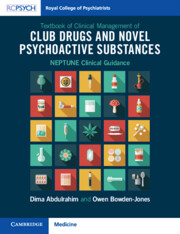 Textbook of Clinical Management of Club Drugs and Novel Psychoactive Substances
Textbook of Clinical Management of Club Drugs and Novel Psychoactive Substances Book contents
- Textbook of Clinical Management of Club Drugs and Novel Psychoactive Substances
- Textbook of Clinical Management of Club Drugs and Novel Psychoactive Substances
- Copyright page
- Contents
- Acknowledgements
- Part I Introduction and Background
- Part II Drugs with Primarily Depressant Effects
- Part III Drugs with Primarily Stimulant Effects
- Part IV Drugs with Primarily Hallucinogenic Effects
- Part V Synthetic Cannabinoid Receptor Agonists
- Part VI Concluding Remarks
- Chapter 14 Conclusion
- Index
Chapter 14 - Conclusion
from Part VI - Concluding Remarks
Published online by Cambridge University Press: 06 October 2022
- Textbook of Clinical Management of Club Drugs and Novel Psychoactive Substances
- Textbook of Clinical Management of Club Drugs and Novel Psychoactive Substances
- Copyright page
- Contents
- Acknowledgements
- Part I Introduction and Background
- Part II Drugs with Primarily Depressant Effects
- Part III Drugs with Primarily Stimulant Effects
- Part IV Drugs with Primarily Hallucinogenic Effects
- Part V Synthetic Cannabinoid Receptor Agonists
- Part VI Concluding Remarks
- Chapter 14 Conclusion
- Index
Summary
This is the first textbook to undertake a comprehensive, in-depth review of the literature relating to novel psychoactive substances (NPS) and club drug harms and their clinical management. The book builds on the work of the NEPTUNE project, which has been reviewing the evidence on this fast-moving area for the last decade. Some predicted that NPS would be a short-lived phenomenon; however, drug markets continue to rapidly evolve with new, and typically more harmful, substances appearing with alarming frequency. The increased role of the Internet and social media platforms to sell drugs, including NPS and club drugs, is a further example of the pace of change.
At the time of writing, the range of substances available on drug markets has never been wider. While NPS have not replaced existing illegal drugs, they are now established throughout drug markets both in terms of substances that people seek to use, as well as substances that are used to adulterate other drugs, including counterfeit medications, with sometimes catastrophic results. The mortality resulting from adulteration of illegal drugs with opioid NPS such as fentanyl analogues, is a devastating example.
- Type
- Chapter
- Information
- Textbook of Clinical Management of Club Drugs and Novel Psychoactive SubstancesNEPTUNE Clinical Guidance, pp. 329Publisher: Cambridge University PressPrint publication year: 2022
